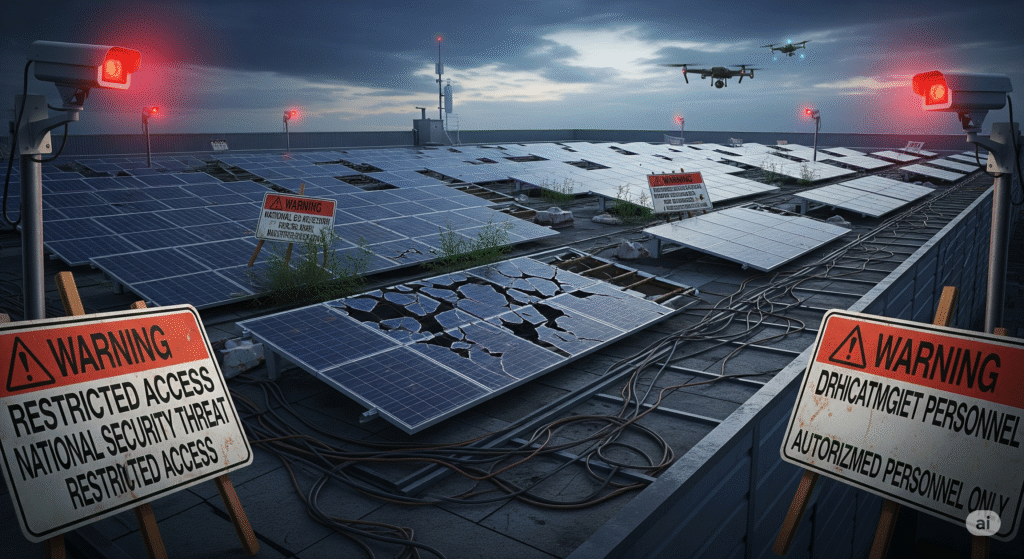How Your Rooftop Solar Became a National Security Issue

Today’s rooftop solar inverters aren’t just power boxes—they’re networked computers connected to your Wi-Fi and, indirectly, to the grid. Vulnerabilities like weak authentication, insecure firmware updates, and undocumented communication modules can scale from a single home to grid-level disruption. Lock down your network, keep firmware current, and demand secure-by-default devices.
Why This Is Suddenly a National Security Story
- Smart inverters = tiny grid nodes. Modern inverters talk to apps, cloud services, and utilities. A flaw replicated across thousands of homes becomes a grid-wide attack surface.
- Government warnings are more specific. Recent advisories have named actual models and described feasible exploits such as malicious firmware updates and remote manipulation.
- Supply-chain twist. Investigations have identified undocumented radios/communication paths in some imported inverters and batteries—raising the risk of out-of-band access and geopolitical leverage.
What’s Actually at Risk?
- Remote manipulation of power flow: Attackers could change set-points, trip devices, or coordinate mass actions that affect grid frequency and stability.
- Data exposure and pivoting: Plain-text traffic, default passwords, and weak APIs can leak owner info or installer credentials, enabling broader intrusions.
- Fleet-scale disruption: Individually, a 5–10 kW system is small. Aggregated across neighborhoods or cities, compromised devices can create spikes, drops, or oscillations that stress the grid.
Action Checklist for Homeowners & Installers
1) Isolate the inverter on your network
- Put it on a separate IoT SSID or VLAN.
- Block inbound WAN access; disable UPnP and any automatic port-forwarding.
2) Fix the basics
- Change all default credentials immediately.
- Use strong, unique passwords and enable MFA in any companion app.
3) Update safely and often
- Apply firmware only from official channels.
- After updating, verify the version/build number and reboot if recommended.
4) Minimize exposed services
- Turn off unused cloud features, remote diagnostics, and local APIs unless essential.
- Prefer HTTPS for local dashboards; if supported, restrict to local-only mode.
5) Monitor and document
- Enable router logs/alerts for unusual outbound traffic from the inverter.
- Keep a one-page handover: network diagram, ports/services used, update steps, and a security contact.
6) Physical and installer hygiene
- Lock the inverter enclosure if possible.
- Ask your installer to deliver a security checklist at handover and to remove any default/temporary accounts.
What Manufacturers Must Do by Default
- Secure boot & signed firmware with verified update paths.
- Encrypted communications end-to-end; no hardcoded credentials.
- Role-based access control with least privilege and audit logs.
- Remote support that’s opt-in, time-bound, and fully logged.
- SBOM (software bill of materials) and clear disclosure so owners know what components are inside and how to patch them.
- Consumer-grade hardening guides shipped with every unit (network isolation, update cadence, known ports, and safe defaults).
Implementation Playbook (Installers/Pros)
- Before install: Plan an isolated VLAN/SSID; pre-create unique device creds; disable UPnP on the customer router.
- During commissioning: Update to the latest stable firmware; disable nonessential services; export a configuration backup.
- Handover: Provide a laminated quick-sheet (update steps, support path, emergency shutdown).
- Aftercare: Offer an annual security check: review logs, rotate credentials, re-verify firmware, re-test isolation.
FAQs
Is this only about one brand?
No. Some advisories name specific models, but the systemic risk spans many vendors because the pattern—cloud-connected, Wi-Fi-enabled, remotely updatable devices—is industry-wide.
Are “hidden radios” a real thing?
Yes. Undocumented or poorly documented communication modules have been identified in certain imported devices, prompting policy reviews and tighter procurement standards.
Could this actually cause a blackout?
A single home won’t. But a coordinated compromise of many devices can create grid instability. That’s why the conversation has shifted from “home gadget security” to “national security.”
If I’m off-grid, am I safe?
You reduce grid-impact risk, but device-level risks remain—privacy, safety, and potential damage from malicious control. You still need strong passwords, segmentation, and firmware hygiene.
Quick Win Settings (Copy/Paste for Your Router)
- Create an SSID named
Home-IoT(WPA2/WPA3, strong passphrase). - Block
Home-IoTfrom accessing your main LAN. - Disable UPnP globally; manually remove any port-forward rules.
- Create a DHCP reservation for the inverter and restrict it to local DNS/NTP only.
- Add an outbound rule: allow only the vendor’s update endpoints (if documented), otherwise default-deny and temporarily allow during updates.
Editor’s Note
This piece distills current best practices and the latest risk patterns around residential solar cybersecurity. It focuses on practical steps any homeowner or installer can implement today, and on the secure-by-default features manufacturers should ship

